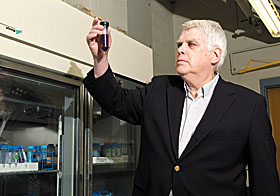  |
| HOME | THIS ISSUE | CALENDAR | GRANTS | BACK ISSUES | < BACK | NEXT > |
Chemistry professor clarifies process that allows humans to see in low lightby Michael Kirk - December 4, 2006 |
||||
| UConn chemistry professor Bob Birge explains a new discovery that he and several Canadian colleagues made about the process that allows humans to see in low light by reciting Robert Frost's poem, "The Road Not Taken." In the poem, a traveler comes upon two roads and chooses to take one path to his destination over the other. It ends with the verses: "Two roads diverged in a wood, and I/I took the one less traveled by ..." In findings published in the journal Science last month, Birge says he and his colleagues have discovered that lasers can manipulate the efficiency of photochemistry in a protein called "bacteriorhodopsin." The discovery has implications not only for this protein, which is a proton pump in an ancient material called "archaea-bacterium," but for all proteins that interact with the human eye that absorb light. The most important retinal protein is rhodopsin, which is responsible for vision in humans and other animals with image-resolving eyes. The study provides further evidence that evolution has created a coherent process to convert light energy into chemical energy in these proteins. It also provides the first evidence that by using laser light, the efficiency of these processes can be increased or decreased by 20 percent. "Most everything in life is incoherent," says Birge. "When we explore options in our lives, we make choices and go down those paths and accept the consequences. In a given day, we make many choices, and because those choices are available each day, each person experiences life differently. To Frost, that was what made life interesting, and in his poem he encouraged people to explore paths not normally taken." But the availability of many options is not always efficient, Birge says. "Sometimes people choose options that set them back and complicate, or thwart, the achievement of goals. Nature has to limit choices to make processes efficient.
In the case of vision, a protein in the back of the eye - rhodopsin - must convert a photon of light into a nerve impulse with high efficiency if we are to have adequate light sensitivity in low light conditions." If evolution converged on a vision process that was completely random, it would be nearly impossible to achieve adequate sensitivity, because most molecules would select paths that led nowhere, says Birge, and the photon's energy would be converted into heat instead of a nerve impulse. But what is surprising is that nature went to the opposite extreme and provided only one path, which means the process is "coherent." That is, it occurs the same way each time at the quantum level. "That is truly unique and unexpected," he says. "And we were able to exploit this coherence by using lasers to enhance the efficiency, or decrease the efficiency, because each and every protein was operating along the exact same microscopic path." This observation has important implications to the mechanism of vision, Birge says. He hopes that some day this basic research will lead to better understanding of diseases that involve rhodopsin, and the retina of the eye. At the end of Frost's poem, the traveler, having chosen which path to take, notes that taking the one less traveled by "has made all the difference." Says Birge, "Apparently nature has preselected the path that all rhodopsin proteins must take during vision down to the atomic level, and that has made all the difference in our ability to see." |
| ADVANCE HOME UCONN HOME |

